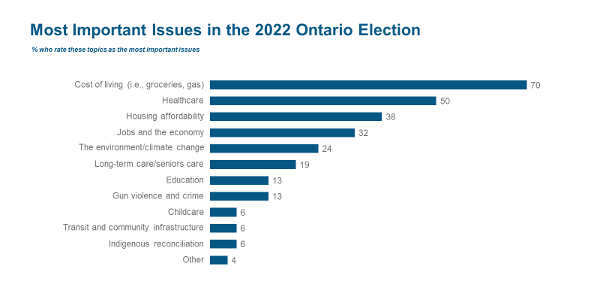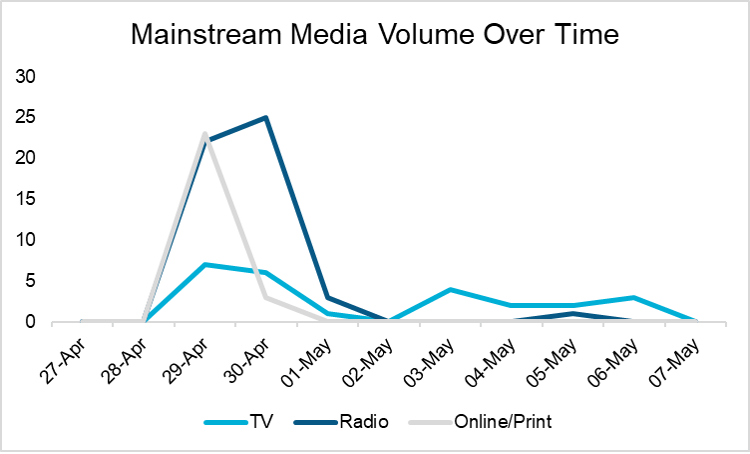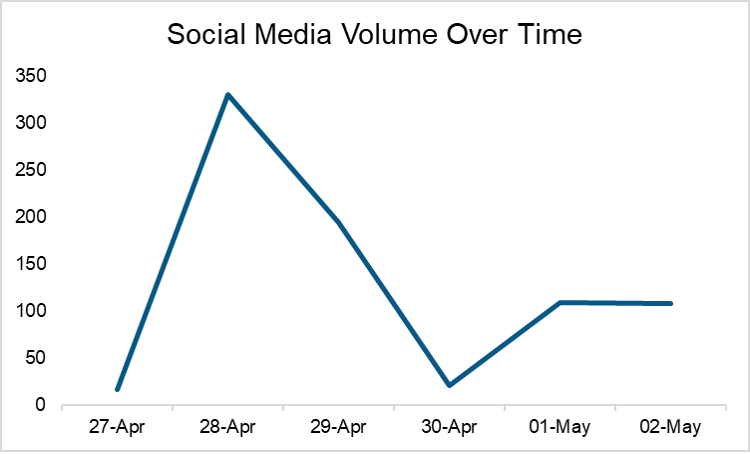Welcome to The Push Back, Navigator’s Ontario elections analysis with a crisis communications twist. We’re bringing our proprietary insights and crisis communications expertise to bear on the issues of the election, from the hubbub of social media to how political messages are landing with voters. We identify exactly what will make or break Ontario’s political leaders and parties as they vie for the governing seat at Queen’s Park.
Ontario’s political parties are already gearing up for the campaign trail. Last week, the PCs released the 2022 Ontario budget, only to have the legislature adjourn without passing the document. It’s clear the Ford government hopes to make their budget a ballot box question as the province approaches election day on June 2.
Research Insights | Ballot Box Questions
Each week, we will ask Ontario voters whether they think political parties are gaining or losing ground on the issues they care about most. In this edition, we’re establishing a benchmark of what issues matter most to Ontarians going into the election, while taking a peek at some of the wedge issues already on the table.
The cost of living is the top concern for voters by a landslide with 7 in 10 Ontarians identifying it as their most important issue in this election. The issue lands 20 points over health care, just as the focus on the pandemic begins to diminish. We can anticipate this issue will drive real competition among parties to prove who has the best plan to make life more affordable for Ontario voters. Surprisingly, transit, child care, and education are all taking a back seat (for now) in this election.

We also did some testing on two hot button issues: housing and the proposed Highway 413 project. Of the housing policies announced by political parties to date, four NDP policies scored highest with over 70 per cent support, including closing loopholes on renovictions (81 per cent), building 69,000 new affordable homes over 10 years (81 per cent), raising property taxes on the rich (72 per cent) and targeting provincial supports to first-time home buyers and renters (72 per cent). While the Liberals have not yet released their full housing platform, their promise to end the practice of Ministerial Zoning Orders (MZOs) received only 48 per cent support. Some good news for the PCs: on Highway 413, we found broad support from 905 voters, with 57 per cent saying they support the project, with overall provincial support for the project resting at 45 per cent.
What We’re Watching
Looking at the week ahead, here are a few things on our radar that could generate some push back between the contending parties.
- Two days before writ drop, Premier Doug Ford and Prime Minister Justin Trudeau made a major $3.6 billion auto investment announcement at Stellantis Monday afternoon in Windsor. Stellantis will retool and modernize their plants in Windsor and Brampton, and build two new research and development centres, to support electric vehicle production.
- Unlike their federal cousins, the Ontario Liberals and NDP have ruled out a coalition if they lose to Ford’s PCs in June.
- Will cheap transit win out over toll-free highways? Del Duca’s Liberals promised they would reduce transit fares to $1 per ride until 2024.
Hold My Beer
On April 25, the NDP released its election platform, and as expected, they were instantly met with criticism from other parties. The Liberals were quick to criticize the platform’s launch by pointing out a seemingly undetected mistake in the cover image – a fellow casually chugging his beer. The Liberal war room was quick to poke fun at the oversight, claiming that’s why the NDP’s “platform math is always so wonky.”
NDP leader Andrea Horwath pushed back by sharing a photo of her enjoying a beer and responded to criticism saying, “After a long day it’s nice to relax with a cold beverage. Cheers, @OLPWarRoom!”
Social Media
Andrea Horwath’s post saw high traction with a total of 1,406 engagements, significantly higher than the Liberal war room’s post with only 261 engagements. Top influencers engaging with these posts include many NDP candidates supporting Andrea Horwath. MPP Catherine Fife shared Horwath’s post and NDP candidate for Nipissing, Erika Lougheed also shared her support by posting a photo of herself enjoying a beer.
The Push Back Verdict – White Noise
We would label this exchange as “white noise,” something that won’t move votes for any side. BUT we give a tip of the hat to Ms. Horwath for effectively pushing back on her critics. Two admirable traits politicians can use to connect with voters are using some humour and not taking oneself too seriously. Ms. Horwath does both here and we don’t think this little incident will impact the party on the campaign trail.
Budget ‘Bait & Switch’
Finance Minister Peter Bethlenfalvy came under fire after not being clear on whether he would commit to re-introducing the same budget if the PC government is re-elected. While the Premier’s office and Ministry of Finance were quick to clarify and indicate the budget will be reintroduced, opposition parties, media and advocacy groups pushed back on the government for not standing behind the commitments made in the document.
NDP leader Andrea Horwath called out the PCs for the “bait and switch” budget, which she believes would result in cuts if they were re-elected. Horwath’s pressure on the PCs budget generated increased media attention, but let’s see how the coverage unfolded.
Mainstream Media
There have been 102 media stories covering this issue since the budget was announced. Coverage is provincewide with some regional outlets syndicating a Toronto Star story. Key outlets reporting include CTV, the Toronto Star, Global News and CityNews.

Social Media
There were 779 mentions on social media regarding the issue from April 27 to May 2. Engagement on social media channels peaked on April 28, the day the budget was announced. Social media conversation was predominantly held via Twitter. Key influencers engaging on this issue include the Paramount Fine Foods CEO Mohamad Fakih and the grassroots movement against the Ford government NotOneSeat, who openly criticized Minister Bethlenfalvy for his refusal to commit to the budget.

The Push Back Verdict – Rolling Stone
We would label this exchange as a “rolling stone” that could end up impacting the PCs’ credibility on the election trail. Given the media traction, we think the NDP will continue to hammer the PCs for introducing a budget they never intended to pass.
We know the opposition can make political hay out of this issue, but it remains to be seen whether it will resonate among voters. We’ll stay tuned and provide an update if we see any movement on this front.
In Other News…
- ICYMI: All three parties released new campaign ads last week—some were heartfelt, and others, less so.
- This past weekend, the PCs and NDP unveiled their campaign buses and the Liberals kicked off their campaign at Del Duca’s nomination meeting in Vaughan—Woodbridge. While reporters will be welcomed on an NDP media bus, there will be no such conveniences for the gallery following the PCs and Liberals on the campaign trail.
- In a new hit ad against Del Duca, the Labourers’ International Union of North America (LiUNA) officially endorsed Ford for Premier, suggesting the Liberals were not ready to lead.
- As inflation rates grow, Del Duca announced his commitment to make mealtime more affordable. On Friday, the Liberals promised to cut the eight per cent provincial portion of HST on prepared foods.
- Del Duca announced the Liberal Party’s commitment to revolutionize long-term care in the province—much like Horwath’s NDPs, he vowed to ban for-profit facilities and emphasize homestyle care.
- As part of their platform, the NDP pledged a four-year tax freeze for low and middle income families. Noted by Horwath, this move is not meant to starve the provincial treasury. Rather, the NDP plan to pay for it by taxing Ontario’s wealthiest corporations and highest-income individuals more.



